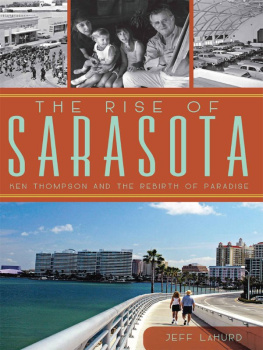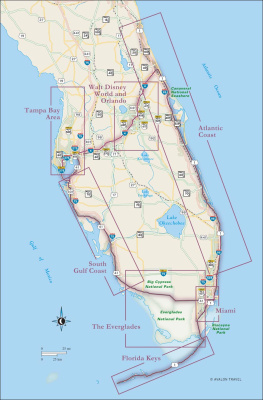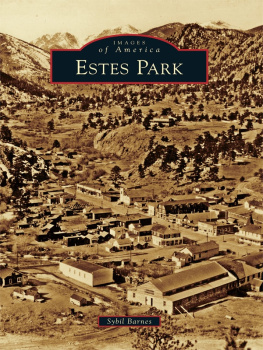

Published by The History Press
Charleston, SC 29403
www.historypress.net
Copyright 2012 by Jeff LaHurd
All rights reserved
Front cover, bottom: Courtesy of Ed Lederman.
All other cover images are courtesy of Barbara Thompson and the Sarasota County History Center.
First published 2012
e-book edition 2012
Manufactured in the United States
ISBN 978.1.61423.765.5
Library of Congress CIP data applied for.
print ISBN 978.1.60949.834.4
Notice: The information in this book is true and complete to the best of our knowledge. It is offered without guarantee on the part of the author or The History Press. The author and The History Press disclaim all liability in connection with the use of this book.
All rights reserved. No part of this book may be reproduced or transmitted in any form whatsoever without prior written permission from the publisher except in the case of brief quotations embodied in critical articles and reviews.
This book is dedicated with love to my beautiful wife,
Jennifermy Dolly Girl.
CONTENTS
ACKNOWLEDGEMENTS
I would like to thank Barbara Thompson for allowing me free access to Ken Thompsons papers and for providing me with many of the photographs I have used in this book. Im grateful to his children (Ken, Charles and Laura Thompson DeUnger) and his grandchildren (Amanda DeUnger Lewis and Alexandra DeUnger) for corresponding with me. Their memories helped me understand Thompson the family man.
Thank you to my friend Scott Proffitt for helping to edit and make corrections to this book before it went to the publisher.
Thank you to the former mayors and commissionersElmer Berkel, Jack Gurney, Kerry Kirschner, Lou Ann Palmer, Rita Roehr and Fred Sotowho helped me understand what it was like to work with Sarasotas long-lived city manager.
Thanks to Ed James, former journalist, community activist and host of the television show Black Almanac for his insights into how Thompson integrated the Sarasota Library with a phone call. And also to Bruce E. Franklin, president of Land Resource Strategies, LLC, and Paul Thorpe, Mister Downtown Sarasota, for sharing their knowledge of how Thompson got things done.
Most of the photographs in this book that were not supplied by Mrs. Thompson were from the collection at the Sarasota County History Center, and most of those came from the George I. Pete Esthus Collection.
INTRODUCTION
Twenty-five years have come and gone since Ken Thompson was forced to leave the city manager position he came to define. And just as the Sarasota he arrived in to take up his duties on February 1, 1950, was shaped by the land boom of the 1920s, so too has todays Sarasota been shaped by his thirty-eight-year tenure as the longest-serving city manager in the nation.
Early on, he had a vision of what Sarasota could become, and slowly, methodically and with a cautious eye on the city coffers, he helped mold this beautiful city to that vision.
During his time in office, nearly three dozen mayors came and went, as did countless city commissioners and myriad city personnel. He was the constant, the captain at the helm of a ship with an ever-changing crew. He was the consummate professional; his intelligence, honesty and integrity were unquestioned. Elmer Berkel, one of the mayors Thompson served in the 1970s, called him the most brilliant man he had ever met. Another mayor, Jack Gurney, thought of him as a patrician gentleman.
Thompson brought to the job an analytical mind and a penurious nature with the tax dollar that would prevent a throw-money-at-it approach to problem solving. He had a deep-seated belief in the commissioner/city manager form of local government, and when he came to Sarasota from Miami Beach, he said he had come to stay, and stay he did.
He was thirty-nine years old when he was hired, seventy-seven when he retired and ninety-one when he passed away, remembered, as Sarasota Herald-Tribune editor Waldo Proffitt put it, for his rock-solid integrity in private and public life. It is at the core of his legacy and it is the quality by which he would most want to be measured.
Proffitt called him the architect of Sarasota.
WELCOME TO SARASOTA
He doesnt manipulate the commissioners, but sometimes hell drag his feet a little until he thinks its right.
Mayor William Overton
In 1950, the city of Sarasota was very much as it had been since the first major development spurt of the frenetic 1920s. In fact, if you came to town in 1925 and returned in 1950, except for the addition of some major Works Progress Administration projects in the 1930s, you would have seen very little change.
The predominant architecture was still the Mediterranean Revival, Spanish Mission or Neoclassical of old. Roads were narrow, two lanes, and deteriorating. Traffic lights were scant. City business was conducted in the old Hover Arcade building at the foot of lower Main Street on the bay and would be into the 1960s. The pace was relaxed, the out islands practically devoid of development.
Downtown in the early 1950s was still the center of Sarasotas universe, filled with lounges, hotels, restaurants, two theaters, churches, car dealers, department stores, drugstores and banks (there were just three), and as U.S. Highway 41 still ran along Main Street, gas stations lined the way to service the stream of cars and trucks passing through town.
There were only four tall buildings within the city limits, all built in the mid-1920s: the Sarasota Terrace Hotel, the Orange Blossom Hotel, the Hotel Sarasota and the Palmer Bank.
The bridge to Lido, built by John Ringling and gifted to the city in 1927, was showing its age in the 1950s, while the Siesta Bridge was frightfully narrow and the Stickney Point Bridge was still a one-lane, hand-cranked swivel bridge.
The local roads of 1950 needed repair and widening, the water/sewer system was in urgent need of upgrade and the mosquito problem, especially during the evening hours of summer, was desperate.
Most visitors still arrived here by car, train or bus, and the Sarasota-Bradenton Airport was better suited to a small town rather than a city striving to capture its share of the postWorld War II boom and move forward.
During the off-season, business revenue fell so dramatically that store owners sometimes closed their stores at noon to go fishing, hopeful that they had made enough revenue during the snowbird season to tide them through the lean summer months.
And while many recall these laid-back days with nostalgic fondness, they forget that from its earliest years Sarasota was not about being relaxed and slow paced but rather about growth, about selling real estate and attracting tourists and newcomers and about the requisite development to invite and accommodate them.
With the notable exception of Bertha Palmer, Sarasotas early leaders were mostly real estate people and developers: John Hamilton Gillespie, Harry Higel, A.B. Edwards, Joseph Lord, Owen Burns, John and Charles Ringling and countless others. They were visionary capitalists, aware of Sarasotas potential, who strove to fulfill the towns early motto: May Sarasota Prosper, adopted in 1902.
The board of trade, which morphed into the chamber of commerce, was also a strong, pro-growth voice, as were Sarasotas newspapers: the Sarasota Times, the Sarasota Herald, This Week in Sarasota, the Daily Tribune
Next page












